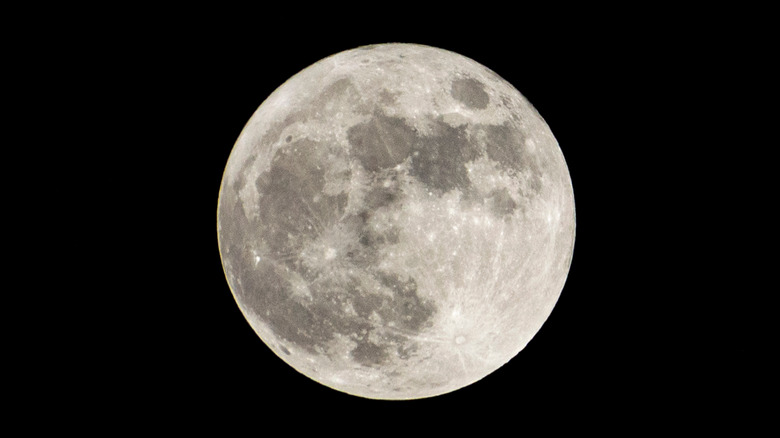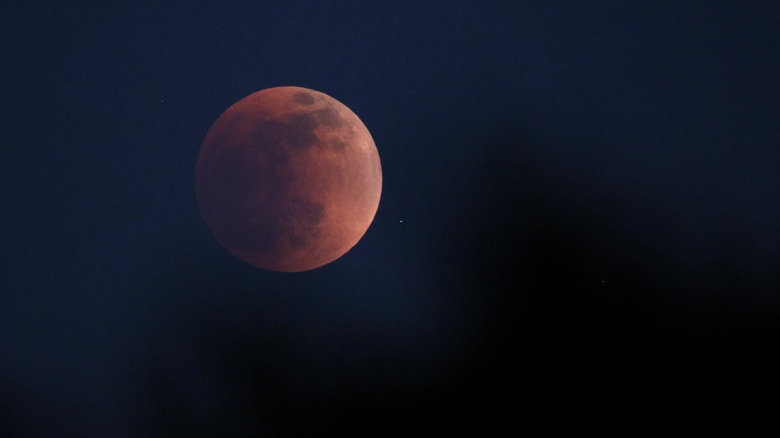How Long Does A 'Day' On The Moon Really Last?
The moon — it's that thing in the night sky that comes in a whole host of varieties: full, new, crescent, waning, waxing, blood, eclipsed, and once in a blue moon, blue. Even though it's easy to take the moon for granted, our most stalwart celestial neighbor is actually pretty unique.
Our moon just happens to be the right size, for instance, and orbit at the precise distance, to perfectly blot out the sun now and then in a solar eclipse. Possibly a piece of galactic shrapnel formed from the collision of the proto-planet Theia with Earth (via Space), the moon's gravitational, ocean-churning tug might be the reason we've got life on Earth at all (via Scientific American). Also, the moon is what's called "tidally locked." Meaning, it doesn't spin around. This is why the same features of the moon face us at all times, such as the giant, circular Tycho Crater surrounded by a brighter patch of the moon's surface.
How do we measure a day on the moon, then? This is why such a simple question as "how long is a day on the moon?" is far more complicated than you might expect.
Cycles locked in cycles
In a common, everyday sense, we tend to say that the moon completes a "lunar cycle" in 28 days. During this time, the moon goes from full to new, shrinks to a sliver, swells out again, and the counter resets. This is why the moon, swelling like a womb, provides the eternally handy analogy to menstrual cycles that's long-since characterized the moon's connection to femininity (HuffPost has a decent summary).
Even though the moon doesn't spin, to our eyes, during those 28 days it does actually rotate. It rotates around its axis as it revolves around Earth, lock-step. This is the exact definition of "tidally locked," which is why the moon's same face points in our direction the entire 28-day revolution, as Universe Today explains. One revolution around Earth synchronizes with one lunar rotation. This might make you think, "Well, since one rotation of the moon equals one revolution around Earth, and one rotation of Earth equals one terrestrial day, sunrise to sunset, then one lunar day equals one revolution of the moon around Earth."
For practical purposes, this is true. But because Earth is rotating around the sun, and the moon around Earth, the moon is always a little behind. It takes an extra 2.2 days to catch up with Earth's rotation. Plus, its orbit isn't a perfect 28 days; it's 27 days, seven hours, 43 minutes, and 11.5 seconds. Grand total for a lunar day? As NASA says: 29.53 Earth days, or 708.7 hours.
More eccentric than it seems
Because we're dealing with space, even something simple like a lunar day gets even more complex from here. Space is a dynamic and changing environment. It may seem static to the naked eye, but that's just because we humans can't easily comprehend the scale or timeline of space.
The extra 2.2 days needed for the moon to catch up to the Earth's revolution around the sun account for the difference between it's "sidereal" and "synodic" day, via Universe Today. A sidereal day describes the moon's single rotation relative to the stars. A synodic day describes its rotation relative to Earth, where it returns to its original starting position. The latter is our 29.53 Earth-day lunar day.
But Earth — and here's the kicker — doesn't have a perfect 24-hour-day, as NASA explains. Its orbit is "eccentric," i.e., an elongated ellipse rather than a perfect circle. Plus, the Earth is tilted on its axis, so its rotation is "oblique." This obliquity of its eccentricity (bear with us here) means that Earth's day actually varies from 21 seconds shorter to 29 seconds longer throughout the year. Our 24-hour day is actually an average known as the "mean solar day." What does this mean for the moon? Even a synodic lunar day can vary from 6 hours shorter to 7 hours longer throughout the year. 29.53 is also an average, i.e., the "mean moon day."


